Peter MALONE
Saturday, 18 September 2021 19:43
Seven Cities of Gold
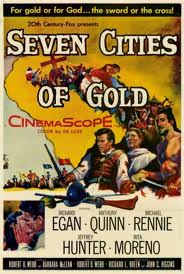
SEVEN CITIES OF GOLD
US, 1955, 103 minutes, Colour.
Richard Egan, Anthony Quinn, Michael Rennie, Jeffrey Hunter, Rita Moreno.
Directed by Robert D. Webb.
Seven Cities of Gold is an early Cinemascope film, a spectacular look at a Spanish expedition in California in the 18th century, the search for fabled cities of gold.
Richard Egan and Anthony Quinn lead the Spanish expedition. Jeffrey Hunter and Rita Moreno portray Indians. Of particular interest, especially for the religious history of California, is the presence of Michael Rennie as Father Junipero Serra, the Franciscan who established so many of the mission towns along the California coast.
This particular film focuses on the San Diego mission. Father Serra is venerated all along the California coast as a pioneer of Christianity as well as a humane intermediary between the Spaniards and the Indians.
The film was directed by Robert D. Webb, a second-unit director for many decades before beginning to direct films in the early 1950s. He directed a number of action adventures including White Feather, Beneath the Twelve Mile Reef and directed Elvis Presley’s first film, Love Me Tender.
1. How enjoyable an adventure film? The appeal of adventure ingredients? Colour, widescreen?
2. The film as an aspect of American history? Its interest, portrayal of the American heritage? Its value in this regard?
3. The sketching in of the background of Mexico, Spain, the exploration of California? The Spanish adventurers, the Indians and their hostility? The truth of such fables as The Seven Cities of Gold? As motivation for adventure and pioneering? The role of the Church?
4. The portrayal of the Spanish authorities and their arrogance? The initial encounter with Portola and Jose? Life and death? Authority and ambition, greed and power?
5. The initial contrast with Father Serra? The film’s portrayal of Father Serra as a person? As a Franciscan and a priest? His religious motivation and dedication? His physical disability and yet his endurance? His attitude toward the missionary work of the Church? His attitude towards people?
6. The reason for Father Serra's going on the expedition? The contrast of his goals with the goals of greed and gold? The contrast of motivations, of Church and State? The scene of his blessing the troops? The types of people who went on such expeditions?
7. The portrayal of the expedition itself, difficulties and endurance? The clashes with the Indians? Sieges and suffering, death, diplomacy? Comment on the attitude of the Spaniards towards the Indians?
8. How sympathetic was the portrayal of the Indians? Matuwer as the Indian hero? His grandfather?
9. The arrogance of Jose and his ambitions during exploration? His infatuation with Ula? Love and its consequences? The significance of her happiness in life, the suddenness of her death?
10. The consequences of love and death? For the Indians in terms of vengeance? For the Spaniards in terms of self protection and sacrificing Jose?
11. How well drawn was the character of Jose? His anti-religious attitides? Father Serra's friendship? His final change of heart, Mass and Communion? His self sacrifice? How convincing?
12. The film's comments on the expedition? How much failure, how much success? Their moving away, Father Serra’s disappointment, the fleet arriving and the pioneering going on?
13. How enjoyable, interesting and valuable are such mixtures of fact and fiction in American history and pioneering?
Published in Movie Reviews
Published in
Movie Reviews
Tagged under
Saturday, 18 September 2021 19:43
Seven Samurai, The / Shichinin No Samurai
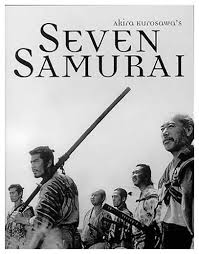
THE SEVEN SAMURAI (SHICHININ NO SAMURAI)
Japan, 1954, 160 minutes (restored version 207 minutes), Black and white.
Takashi Shimura, Toshira Mifune.
Directed by Akira Kurosawa.
The Seven Samurai is considered the masterpiece of Samurai action. It is considered a classic. It had a great influence in Japanese cinema, especially with Kurosawa himself moving into a great number of Samurai films from this period including Throne of Blood, his variation on Macbeth, Yojimbo and Sanjuro which were very influential on Sergio Leone and his Fistful of Dollars films. Kurosawa is not confined to Samurai films, making such classics as Living and adaptations of Ed McBain? with High and Low. This film was made in striking black and white. In the 1970s, Kurosawa moved to colour with two Samurai films, Ran (his version of King Lear) and Kagemusha.
The plot of the film is very simple. A village in trouble hires seven Samurai to protect it from bandits. The plot has become very familiar to western audiences in the American adaptation, The Magnificent Seven.
Kurosawa is considered one of the major film directors of the 20th century.
1. This is considered a classic Samurai film. Can you understand why? Its epic scope, its dealing with Japanese legend, with the life of the people, the vastness of the events, characterizations, an insight into the events? Which were its major successful features?
2. How well communicated was the Samurai background? The role and importance of the Samurai in Japanese society? Their attitudes and arrogance? Their skill? Their violence? The contrast with the poor? Their contrast with bandits? The need for survival, the ups and downs of the Samurai's reputation? Their nobility? What insight into the Samurai did the film give?
3. Comment on the structure of the film and its success: the portrayal of the peasants' plight, the bandits' cruelty and the desperation for the peasants; the details of the search for the Samurai and the introduction to them; the Samurai as persons; the work of the Samurai and the prosperity of the village; the siege; the deaths of the Samurai and the peasants' survival.
4. How important was the contribution of the black and white photography, the locations and their atmosphere, the atmosphere of village and Samurai, the presentation of real people in close-up, the vast amount of time of the film's duration, the musical background, the sparse dialogue and the stylistic characterisations.
5. How did the film communicate the plight of the villagers - the details of their work, information about them and their crops, their fears, their meetings, the interactions for decisions, the horror of the bandits and their robbery and massacres? The audience's identifying with the ordinary plight of the poor?
6. How entertaining were the recruiting sequences? The peasants out of place in the town, searching for Samurai, searching for poor Samurai? Their amazement at Samurai's skills? The individual Samurai - what characterised them, what communicated their individuality to the audiences? How was this done in incident and detail?
7. How important was Kikuchyo? As a focus for the Samurai, as a peasant, his following the Samurai and his determination, his craziness and ambitions? Did his humour add to the film? How did he contrast with Samurai ideals and how did he achieve them? The possibility of audiences identifying with him?
8. The impact of the Samurai's contribution to village life, the details of the defences, the possibilities of the villagers growing their crops? The interaction of Samurai and villagers, fear, co-operation, the love story? was this convincing? What insight into human behaviour and interaction and trust did these sequences give?
9. The importance of the battles for the film? As a Samurai film? Samurai skill? The details of the battles?
10. What judgment did the film make about the outcome of the battles - those who remained alive, the reality of deaths, the heroism in dying for others, the peasants remaining alive with their land? What did the Samurai have? What insight into heroism did the film give?
11. What overall impression of skilfulness in film-making did this film give?
Published in Movie Reviews
Published in
Movie Reviews
Tagged under
Saturday, 18 September 2021 19:43
Seven Seas to Calais / Il Dominatore Dei Sette Mari
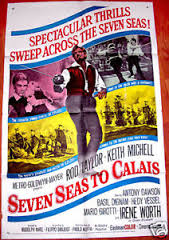
SEVEN SEAS TO CALAIS (IL DOMINATORE DEI SETTE MARI)
Italy, 1962, 102 minutes, Colour.
Rod Taylor, Keith Michell, Edy Vessel, Mario Girotti (Terence Hill), Basil Dignam, Anthony Dawson, Irene Worth.
Directed by Rudolph Mate and Primo Zeglio.
Seven Seas to Calais is matinee material, produced in Italy at the period of sword and sandals epics. Rod Taylor appears as Sir Francis Drake, Irene Worth as Queen Elizabeth, Basil Dignam as Sir Francis Walsingham. Keith Michell has the role of the hero, Malcolm Marsh.
The film is an action adventure, Francis Drake and his expedition to the New World, stealing gold from the Spaniards, clashing with the Spaniards, returning to England to protect Queen Elizabeth from the spies at her court.
The film is not a classic – much more matinee-style material, undemanding.
The film was directed by cinematographer Rudolph Mate who had photographed such classics as Dreyer’s Vampyr. He began to direct in Hollywood in the late 1940s and made a number of action adventures, The Black Shield of Falworth, Siege at Red River as well as the drama Miracle in the Rain. This was his last film.
1. How enjoyable an adventure was this? For what audience was it made? What age?
2. How successful an adventure was this? Matinee excitement? The characteristics and quality of matinee adventure?
3. How well did the film blend adventure and history? How important was the history? People's knowledge of Drake and Elizabeth? Theri response to Drake and Elizabeth?
4. How well portrayed was the character of Drake? The portrayal of his background of sailor? Pirate, the search for gold? his being used by Elizabeth? His capacity for exploration and adventure? The importance of his role in the mutiny? His skill as a sailor in the calm, confronting the Spaniards, the search for gold? The success of his mission and his still being used by the Queen? His knighthood? The drama of his saving Elizabeth from assassination? The portrayal of his role against the Armada: The sequence with the bowls, his strategy In misleading the Spanish. his successful fights?
5. What kind of a hero was Drake? His reputation in history? His heroics? As a swashbuckling adventurer of the sixteenth century?
6. Drake’s assistant: as associated with Drake, his pride in sailing with Drake, his loyalty to Elizabeth, relationship with Arabella, his role in the mutiny, his work on the ship, his role in the Spanish adventures, his infatuation with the Indian girl, the comedy of his escape? His relationship to Arabella and saving her? How interesting a character was he? How much an image of Drake? Again, a typical sixteenth century hero?
7. How well was Elizabeth portrayed in the film? Did she compare with the usual picture of her? Her role in England, her strategies, enmity with Spain. using people, protecting them? What kind of queen was she? how admirable?
8. The importance of the scenes with the Indians? Friendly relationships? The discussion of loyalties? Leaving the assistant behind? The British using the natives?
9. The importance of the mutiny sequence and Drake's power over his men?
10.How interesting was the Babbington plot? Its being interwoven with the other adventures? The Spanish intrigue? The role of Mary Queen of Scots?
11.How interesting were the sequences with the Spaniards? Were they portrayed in too black a light? As suitable villains for this adventure heroism?
12.Was the resolution satisfactory for this kind of film? What value has a film like this? A touch of history and a touch of entertainment?
Published in Movie Reviews
Published in
Movie Reviews
Tagged under
Saturday, 18 September 2021 19:43
Seven Thieves
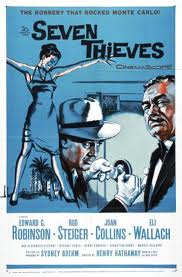
SEVEN THIEVES
US, 1961, 102 minutes, Black and white.
Edward G. Robinson, Rod Steiger, Joan Collins, Eli Wallach.
Directed by Henry Hathaway.
Seven Thieves is a low-key robbery action drama. The film focuses more on the psychology of the participants, although it gives some attention to the robbery itself.
Edward G. Robinson appears as a professor who wants to rob the casino at Monte Carlo. He draws up a team, led by Rod Steiger. Joan Collins also appears as the femme fatale and has a few musical numbers. Eli Wallach is also one of the team. Sebastian Cabot is the casino director.
The film is sombre, made in black and white. It was directed by Henry Hathaway who had a long career from the 1930s, making the first Technicolor western, Trail of the Lonesome Pine. He also directed a number of almost documentary-like films in the 1940s, House on 92nd Street, Call Northside 777.
In the 1950s he also directed a number of action adventures in Cinemascope and a number of westerns, especially True Grit, for which John Wayne won his Oscar.
1. Did this film differ in any way from routine robbery thrillers?
2. What mood did the gambling and dancing credit sequences suggest?
3. What was more important in this film, the robbery or the characters? Why?
4. The film had a long introduction with the Professor and Paul in differing locales. Why? What was the effect of this? How well constructed were these sequences?
5. What kind of man was the Professor? As a person? as a criminal? as ambitious to be remembered? as taking his crime as an experiment and a challenge? Did Edward G. Robinson make him credible, likeable?
6. What kind of criminal was Paul? Why did he hesitate so long to join the plan? Did Rod Steiger make him likeable? How well did Paul and the Professor relate? Did you realise they were father and son before the audience was told? Why did Paul help the Professor?
7. Were the accomplices well drawn as characters ? how? The German, the safe~breaker?
8. Much time was spent showing the relationship between Melanie, Pancho and Raymond. especially the saxophone and the dance? Why? Did this add to the mood of the film? understanding of how each of them ticked and why they were all involvedt in the crime; how they could be made to be involved?
9. How effective was the filming of the planning and the rehersals, especially Pancho and the Professor? Did you understand how they would do it?
10. How exciting was the robbery sequence? Why was it interesting and exciting? What contribution did the performance of each character (and the film editing) make? Professor's suaveness, Paul's coolness, panic, Melanie’s opening the window, Pancho's refusal to bite the pill, Raymond's nervousness. the English doctor and the Professor's answer for everything?
11. Should the film have gone on as long as it did? Was the ending appropriate or not?
12. Was the returning of the money the only possible course? Why?
13. Did It matter that the Professor died without seeing the money? Why was the smiling?
14. Was Paul and Melanie’s collaboration made credible?
15. How ironic was the return of the money after all the trouble taken?
Published in Movie Reviews
Published in
Movie Reviews
Tagged under
Saturday, 18 September 2021 19:43
Seventh Cross, The
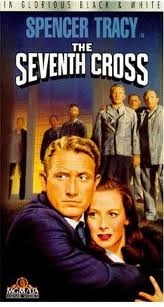
THE SEVENTH CROSS
US, 1944, 110 minutes, Black and white.
Spencer Tracy, Signe Hasso, Hume Cronyn, Jessica Tandy, Agnes Moorhead, Ray Collins, Felix Bressart, George Macready.
Directed by Fred Zinnemann.
A strong anti-Nazi propaganda film of 1944. Produced by M.G.M. with its customary finesse and gloss, the film was director Fred Zinnemann's first major directorial work. He was to go on to fame with such films as High Noon, The Sundowners, A Man for all Seasons, Julia. Spencer Tracy is the hero and gives quiet strength to his role, even though his actions are frequently being described rather than dramatised. In support are Hume Cronyn and Jessica Tandy, the distinguished acting husband and wife team of the American stage. The film is dated, seems very strongly anti-German. but reflects the feeling of the mid-forties.
1. The quality of the film as an adventure story, as anti-German war propaganda, its impact in the forties, now?
2. The quality of forties film-making: black and white photography, light and shadow, studios and special effects for European settings? Musical score? Spencer Tracy as a star of the time? His contribution to the propaganda and war effort?
3. The themes were those of the thirties and forties, totalitarianism, hysteria and cruelty and fanaticism. The universality of these themes? Their relevance in later decades? Later decades remembering these realities? The universal treatment of these themes? The particular propaganda against the Germans, hysteria and cruelty? The effect on American audiences of this kind of film in its time?
4. The quality of the film as a chase story: the building up of suspense from the concentration camp, the capture of the escapees, the constant present of detection, weariness and using one's wits, the hostility of the populace, the unreliability of friends, the support of friends?
5. How clear were the German issues, the imprisonment issues? The reasons for the initial escaping group being in the concentration camp - as they were explained? Hitler and his presence, the Jews and their extermination to come, the crowds caught up in the atmosphere, the ordinary citizens ignorant and going about their ordinary work, focusing on money and prosperity? The background to World War II?
6. What was the effect of the narrative structure, the commentaries, so much of the action described and illustrated rather than dramatised? The moral tone given by such descriptive narrative? The emotional impact, the effect for audience response to the themes?
7. The opening escape - the explanation of those escaping and their backgrounds, the various ways in which they were caught, tortured and killed? The seven crosses? The presentation of the Germans - how fairly? Their vindictiveness, the torture?
8. The narrowing to George as hero? As described when we first see him, his background and people's admiration for him, his hiding and the build-up of fear, hunger, the encounter with the little girl and the plane, jumping the fence and hurting his hand, the stealing of the coat and the reaction of the boys and the police and the possibility of death? Focusing on issues of life and death by connecting them with children? The hitch-hiking and the truck driver, his photo in the papers, travelling on trains, the landlady and her reporting him? The reality of ever present danger?
9. The German attempts to catch him? How well were these illustrated and giving a sense of the danger to George?
10. The delineation of Franc and the others who were wanting to help him, preparation of documents, secret meetings, covers? Contacts and the way of getting in touch with people? The over present Gestapo? The interlude with Sauer and the bond with George, his putting Paul off, his wife's rebuke and his further action?
11. Audience identification with Paul and his wife? Family, ignorant of the politics of the time, seeking prosperity? Caught up with their ordinary small world? Their decision to help? Paul's rising to the occasion, getting help from Fiedler? arranging for the room for George? The importance of his visit to Sauer, his arrest and interrogation and his reporting of this? The literally small man rising to a heroic response? The nature of true friendship? Paul's wife and her friendship, the suffering at his being taken by the Gestapo? The morale boosting by presenting these ordinary citizens responding to crisis?
12. Toni as attractive heroine, suspicions by the audience, perhaps the temptation to get the money, George's treatment of her, the making of the bed, his courtesy, their falling love and the backing and support that this gave to George?
13. The portrait gallery of the supporting characters and their contribution for example the sewing lady and her giving of the suit with the money, the old man bringing the sandwich and his parable of the ants?
14. The build-up to the final escape and success? The 7th cross, without its victim? How much humanity was there in the film, the constant sections about hope in humanity? Film as a good way of communicating propaganda?
Published in Movie Reviews
Published in
Movie Reviews
Tagged under
Saturday, 18 September 2021 19:43
Seventh Dawn, The
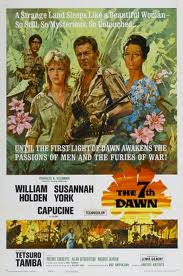
THE SEVENTH DAWN
US, 1964, 123 minutes, Colour.
William Holden, Susannah York, Capucine, Tetsuro Tamba, Michael Goodliffe, Maurice Denham, Allan Cuthbertson, Sidney Tafler.
Directed by Lewis Gilbert.
A big budget spectacular social entertainment. It was filmed in Malaysia and uses the landscapes and the jungle of that country to great advantage. Director of photography was Freddie Young, who worked on David Lean's films like Lawrence of Arabia and Dr. Zhivago. William Holden is a solid lead and there is Susannah York early in her career. Capucine has quite a good role. There is an excellent British supporting cast led by Michael Goodliffe.
There is a vigorous score by Riz Ortolani. The material has been treated in many adventure films like Richard Thorpe’s Malaya, 1950, with Spencer Tracy, James Stewart and it is the period of The Virgin Soldier stories.
Direction by Lewis Gilbert, who made a number of solid British comedies and action adventures and with films like this moved into the international league and became the director of several James Bond films, including You Only Live Twice, The Spy Who Loved Me and Moonraker.
1. The popularity of this kind of adventure, romance? The basic ingredients of the adventure films?
2. Colour and Panavision photography? The atmosphere of Malaysia and its history? The war, post-war terrorists, influence of multi-nationals? The musical score?
3. The point of view of the screenplay: Malaya and the ultimate emergence of Malaysia? The role of the British during the war? The jungle troops and their becoming terrorists? Marxist influence? The withdrawal of the British? The business role of the United States? The final attitudes towards terrorists, towards the British, towards Ferris?
4. World War II and its atmosphere? The terrorist work against the Japanese? The exhilaration of the Japanese surrender? Ng and his work? Ferris and Dhana working with him? Their tactics and the prediction of the future with the same tactics?
5. The arrival of the British and their take-over? Trumpey and the encounter with Ferris? His gesture in allowing Ng to take the flag? the British authorities after the war and their pomposity - especially Cavendish? Trumpy's return after the war and the hopes for some kind of settlement?
6. The character of Ng: during the war, sympathetic presentation, communistic leanings, his going to Moscow for training, his work as a terrorist and his values? Dhana and her decision not to go with him? her hesitations as the film went on? Ferris going to see him to plead for his stopping his terrorism? Ferris's failure?
7. The character of Ferris: William Holden and his style as American hero? During the war? His decision to stay and his prosperity? The neighbours and the terrorist destruction for example Tarlton, his confrontation with Ferris and wanting to sell his plantation, the ambush and his death? Ferris and the attitudes of the British towards him especially Cavendish and the C.P.O.? The encounter with Trumpey and the friendship from the past? Ferris and his relationship with Dhana - love, taking her for granted? His admiration of her during the demonstration? The meeting with Candace? The party and the deaths? her going to his home? His putting her off? Her being taken as hostage? His mission to Ng and its failure? The later desperation to bring Ng in to save Dhana from execution? His being too late? His refusal of a happy ending with Candace?
8. Dhana and her place during the war, her teaching work, as mistress to Ferris? The importance of the bike demonstration? lier decision to side with the terrorists? The arrest and the fact that Ng had planned her arrest? Imprisonment, trial? The visit of Candace and her substituting herself as hostage? Audience response to the group's being too late and Dhana's execution?
9. Candace as alternate heroine? As Trumpey’s daughter, her boldness in confronting Ferris on his return from the mission, her swimming? The party and the assassinations? her sexual advances and Ferris's rejection? Her visiting Dhana in the prison? Her allowing herself to be taken hostage? The hardships of the journey with Ferris and Ng? Ferris's rejecting her?
10. The picture of emerging nations after World War II, the atmosphere of the East, difficulties? The British and their role and withdrawing? The burning of villages, the demonstrations, British arrogance?
11. How satisfying an action film, the portrayal of dangers, terrorism, betrayal? Conventional material but elaborately and entertainingly done?
Published in Movie Reviews
Published in
Movie Reviews
Tagged under
Saturday, 18 September 2021 19:43
Seventh Seal, The
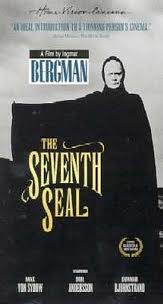
THE SEVENTH SEAL.
Sweden, 1956, 96 minutes, Black and white.
Gunnar Bjornstrand, Bengt Ekarot, Nils Poppe, Max von Sydow, Bibi Andersson, Gunnel Lindblom, Anders Ek.
Directed by Ingmar Bergman.
The Seventh Seal was the film that brought Ingmar Bergman to the attention of the world. He had been working in the Swedish industry since the 1940s, making a great number of very striking and sombre films including Summer Interlude and Summer With Monika. He had the light touch in Smiles of a Summer Night.
However, with The Seventh Seal, he created the metaphysical drama with religious undertones and overtones. Max von Sydow portrays Block, a knight returning from the crusades to his native Sweden, surveying the countryside which has been devastated by the Black Plague. He becomes disillusioned with his mission, with his life, asking questions about the existence of God and God’s providence. He is also pursued by Death. In the most famous scene, stills of which are always reproduced, Block plays chess with Death. However, Death perseveres – and the film concludes with a striking mediaeval dance of death.
Max von Sydow was a strong actor of the Swedish industry at this time and was to appear in a number of Bergman’s films, especially The Virgin Spring. However, he eventually went to Hollywood for The Greatest Story Ever Told and had a forty-year-plus career in many Hollywood films, good, bad and sometimes very bad.
Several of Bergman’s troupe are in this film including Gunnar Bjornstrand, Bibi Andersson and Gunnel Lindblom. The next year Bergman was to make Wild Strawberries, his explanation of old age, with Victor Sjostrom, the veteran Swedish director.
In the 1960s he made the trilogy, metaphysical and religious, Through a Glass Darkly, Winter Light, The Silence. He also made the intense trilogy, Persona, The Hour of the Wolf and Shame. Moving to colour in the 1970s he made the classic film of suffering and death and redemptive love, Cries and Whispers. He also moved into television with Scenes from a Marriage. He continued to make fewer films as he grew older but made a follow-up to Scenes from a Marriage, Saraband, in 2003. He was one of the masters of film-making of the 20th century.
1. The quality of the film as an Ingmar Bergman film? A film of the 1950s? A film reflecting his experience of silence, silence of God? A religious film?
2. The quality of the black and white photography, the re-creation of a mediaeval world, the use of light and darkness, shadows and silhouettes, night and day, the seasons, the weather, the dark and the dry, the storms and the thunder and lightning? Interiors and exteriors? An artificial world, an authentic mediaeval world?
3. The range of musical score - orchestral score, light mediaeval comedy music, the music of theatre, the overtones of solemn chant and religious music, the Dies Irae?
4. The significance of the title, the quotation from the Book of the Apocalypse, the apocalyptic atmosphere of the film - symbols, numbers, images for religious message? The eschatological tone and themes of the film? Angels, the seven seals, heaven and hell, death and judgment, omens, the Riders of the Apocalypse, animals and birds? The visual presentation of horses, birds?
5. How effective was the film as a fable? About the journey of human life? The film as an allegory of life - the knight as the hero, the confrontation with Death, the various characters as aspects of the encounters of life? The film as a pageant ? Of the mediaeval world, imaging the universal world? The characters as types of all time? The importance of clowns, jugglers, wives, knights? The importance of the theatre and its atmosphere, the masks? The relationship of all these attributes to the development of the plot and the treatment of themes?
6. The focus on death - death as personified, as the companion along the way, his appearance, face, dress, the game of chess and the playing and gambling with Death, Death as a trickster and the hearing of the confession, his continual reappearance, his taking the people with him at the end, the dance of death? The various images of death e.g. the masks, the skeleton from whom the squire asked the way and his comment on its eloquence? The reality of death of the main characters? The atmosphere of plague in the Middle Ages and plague as a symbol of death? The discussions about plague and death e.g. of the squire with the painter?
7. The central figure of the knight - as hero, his relationship with his squire and their complementarity, the noble with the ordinary man - with the touch of vulgarity, the background of the Crusades and all that that meant in Christian terms and quests, courage and endurance, participation in war, religious motivations? The squire's later discussion of the Crusades and their futility? The knight and the squire as pilgrims? The search for home, the arrival on the seashore, the knight as living and the confrontation with death, holding death at bay with the game of chess, using tricks? The confession and the knight's presumption in telling his moves and the continual reference to the crucifix and the Crucified Christ? The various confrontations of the knight with death and the significance symbolically and religiously of the pieces for the chess game? The importance of the various encounters that the knight had with the juggler and his wife, with the actors., with the painters, with the smith and his wife? What did he learn throughout his experience? How did his speech about the silence of God indicate his religious torment and search? The knight as a saviour figure especially of the witch? His returning home and re-meeting his wife yet distant from her? The achievement of his life and the inevitability of his death? The knight as a symbol of the Christian? A sombre view of the Christian and his duty through life?
8. The contrast with Jons, the squire? His initial song and its vulgarity, his attitude towards women, asking the way of Death, his drinking and earthiness, the discussion with the painter about the plague and the religious symbolism, with the smith, with the young girl who could be the servant? His comment on life as meaningless, of the Crusades, of his seeming lack of interest in life and deeper realities?
9. The character of the young girl and her quest, her possibility of being a maid, her accompanying the group, what she had learnt, the fact that she would die and join the dance of death? The smith and his encounter with Jons and the drinking, the wife and her watching the play and her going off with the actor? What did they represent about the ordinary struggle of marriage? The fact that they would go with the knight also to death? Skat and his life with Joseph and Maria, his waking up, the mask, his role in the theatre, his taking the smith's wife, the fights, his going to death?
10. How well did the film communicate the atmosphere of plague, the atmosphere of penance, the painter and his philosophy of life, his representing these things in art, the impact that they would have on an audience? (Bergman himself as performing the equivalent function of the painter in giving us the canvas of the film for our response ? learning, being frightened, moral experience?) The fanatics and their flagellation and the contrast with the theatre and the ordinary people enjoying the play, the xl witch and her executioners? The people caught up in this frenzy? The critique of the black side of the Christian Middle Ages?
11. The contrast with Joseph, Maria and their little boy? The presentation of the family group, the overtones of a holy family? Seeing them in the woods, the atmosphere of goodnessp Joseph having a vision and our sharing it, the presence of the Madonna and child to him and his joy? A man of Heaven rather than of Hell? The bond with Maria, the scenes of their mutual love and joy, their love for their child? Their moving through the countryside, Skat and his presence with them? The play and its success? Their experience of fear? Maria as the portrait of the idealised feminine and the echo with the Madonna?
12. Joseph as clown, the quality of his song, a nice and pleasant man, his skill at juggling and play, his visions both real and made up, the fear in the forest and their being saved? The importance of his final vision and that it was he who saw the dance of death? The play and the reflections about the soul of man? Joseph as the good man, the player, the lover and the poet?
13. The significance of the detail of the conversation with thepainter, the situation of the church, the background of the Crusades? Jons and his list~ ening and not listening, his mockery, his comments on women?
14. The significance of the scene with the witch, the knight and his horror, the witch and the brew and her test, her being taken to Death and the ugliness of a civilisation that in the throes of plague could persecute to death?
15. The introduction of Raval, his background, his stealing, the irony of the squire's commenting on his way of life? His previous advice about going to the Crusades?
16. The play within the film - Skat, Joseph and Maria and their acting, the people and their response, the smith's wife? The intrusion of the monks, the monk's speech and the contrast between organised and institutionalised religion and spontaneous religion?
17. The importance of the encounter between the knight and Maria? A man very masculine in his approach to life and in his career being touched by the gracious feminine?
18. The visual presentation of the forest and fear, the witch, the carriage going through the night, the sounds and the winds?
19. The final appearances of Death and the recapitulation of the chess game, the various manoeuvres and their symbolic significance?
20. The character of Karin and her symbolising the knight's home, welcoming the knight, the encounter between the two and the distance, the passing of the years and the absence of love, the knight's goals, the group being welcomed into the house, hospitality and the meal, the significance of Karin's reading the Scriptures and recapitulating the scriptural themes?
21. The group as it faced Death - the significance of the experience of each of those who died, the mediaeval symbol of the dance of death and all joined? The visual of the dance of death - and our sharing the vision of Joseph?
22. The overall effect of the film - experiencing another world, a religious experience, fear, the significance of the painter's remarks about the effect of art? Our sharing a vision and a dream?
Published in Movie Reviews
Published in
Movie Reviews
Tagged under
Saturday, 18 September 2021 19:43
Seventh Sin, The
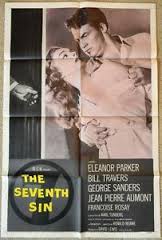
THE SEVENTH SIN
US, 1957, 94 minutes, Black and white.
Eleanor Parker, Jean- Pierre Aumont, George Sanders, Bill Travers, Francoise Rosay, Ellen Corby.
Directed by Ronald Neame.
The Seventh Sin is based on W. Somerset Maugham’s novel The Painted Veil. This was filmed in 1936 with Greta Garbo in the central role. A very fine version was released in 2006 with Ed Norton and Naomi Watts in the central roles, with Liev Schreiber as the other man and Toby Jones as the doctor. Diana Rigg was the mother superior.
In this version, Eleanor Parker is the wife, Bill Travers her husband, Jean-Pierre? Aumont the lover and George Sanders the local doctor. Francoise Rosay is the mother superior.
The film focuses on a woman who marries a doctor and betrays him with an affair. He takes her up-country in China where an epidemic breaks out. She is isolated, has the time to rethink her behaviour, repents, becomes involved in helping the locals, especially with the advice of the mother superior. George Sanders is the local doctor who lives with a Chinese woman – a rather different role for him.
The film was directed by British Ronald Neame, cinematographer for David Lean who began directing in 1950 with Golden Salamander, The Card, The Million-Pound? Note. He directed some classics in England: The Horse’s Mouth and Tunes of Glory before going to the United States where he directed such films as The Chalk Garden, The Prime of Miss Jean Brody, The Poseidon Adventure and The Odessa File.
1. The meaning of the title, its overtones of religion? The original title was The Painted Veil. Which was more appropriate?
2. What is the appeal of this kind of film? For what audience was it made? Indications from the style and screenplay?
3. The use of Cinemascope, Hong Kong and Chinese background? Audience responce to these dramas of the far east? China in the late 40s?
4. The title focused on sin. The film's exploration of sin and goodness, right and wrong, judging of others, offending others and hurt, repentance and reconciliation, repentance and forgiveness as a basis for the future?
5. The dramatic importance of the opening, the presentation of sin, the aligning of sympathies, seeing the character of Caroline, seeing through Paul’s, the judgment on Walter? The consequences of this behaviour?
6. Caroline - as heroine? How attractive, how convincing? The explanation of the background of the marriage, the desperate need to marry, her selfishness in marrying Walter, her selfishness at the dinner, her furtive reactions, the lies? The significance of the confrontation with Walter? The nature of her lack of love, her capacity for hurting, of being hurt by Paul? Her common sense in seeing through Paul through Walter’s eyes? What made her change? The encounter with Tim? The encounter with the nuns? The challenge to selfishness? The enjoyment of her work? The impact of the pregnancy on her, of Walter's death and final forgivenese? What future did she have?
7. Did the film give an adequate insight into the nature of a woman and of a woman unhappily in love?
8. How interesting was the character of Walter? his stolid nature and humourlessness, his love for Carol, lust? the hardness, working? His severity on her behaviour during the plague? His gradual acceptance of her repentance? His finally forgiving her? Was he a good man?
9. How conventional a casual person was Paul? His using of Carol? Her loving of him?
10.The role of Tim? A convincing character? his inquisitiveness, taking Carol to the nuns? The sudden revelation of his Chinese wife ans his love for her? How admirable a character? How credible?
11. The presentation of the nuns? As human beings, as involved in their work, as sympathetic? The influence of the superior?
12.Did the film achieve a right blend between sentiment and realistic feeling?
13.Could the film be rightly described as religious? In its themes, in the explicitly religious characters?
14.What is the overall effect of this kind of fiim? Insight, conviction?
Published in Movie Reviews
Published in
Movie Reviews
Tagged under
Saturday, 18 September 2021 19:43
Seventh Voyage of Sinbad, The

THE SEVENTH VOYAGE OF SINBAD
US, 1958, 88 minutes, Colour.
Kerwin Matthews, Kathryn Grant, Richard Eyer, Torin Thatcher, Danny Green.
Directed by Nathan Juran.
The Seventh Voyage of Sinbad is the first film for Ray Harryhausen, the master of special effects who made such effective contribution to the development of effects during the 1960s and 70s. Jason and the Argonauts is also considered one of his best films. He continued work even into the 80s and 90s with such bigger-budget films as The Clash of the Titans.
This film has regular Sinbad adventures from the 1001 Nights. Kerwin Matthews is Sinbad and Kathryn Grant the princess. Torin Thatcher enjoys himself as the evil magician.
The film was directed by Nathan Juran, a set designer who became a director, especially of smaller-budget films and some of the Audie Murphy westerns of the 1950s.
1. How enjoyable and successful the film as an adventure?
2. Its use of the adventure ingredients, the handsome hero, the princess-heroine, the magician-villain, threats, quests, dramatic climax?
3. The contribution of the colour, the ship and the sea, the
atmosphere of Baghdad,, the banquet, the island and its mysteries? How did these add to the enjoyment? To the imagination?
4. Dynamation and its effect? Which were the best effects? Audience response to this fantasy and skill? Sinbad as hero, the atmosphere of legend? An agreeable hero?
6. The Caliphs, their meeting and suspicions, the banquet? Storybook caliphs and Baghdad?
7. How attractive the princess? The effect of her being made small? The happy endingy sharing Sinbad's dangers?
8. How interesting and convincing the magician? The story of the lamp, his plots to sail again, his cruelty, the magic at court, his prophecy of doom, his reducing the princess, the voyage, his cruelty to the sailors, his final pursuit of Sinbad, his death by the dragon? What particular evil was characteristic of him? His greed and lack of scruples?
9. The portrayal of the loyal sailors, the villains from the prison, their being mad at the sounds of the sea, their greed at wealth, the nature of their deaths?
10. The impact of the Cyclops, the dragon, the giant birds? What kind of evil did they signfiy? The drama of the dangers and the fights?
11. The princess freeing them when she was small, the drama of her restoral? The story of the genie and his personality? His helping them? Magic goodness?
12. The appeal of the fairytale ingredients and audience imaginative response?
Published in Movie Reviews
Published in
Movie Reviews
Tagged under
Saturday, 18 September 2021 19:43
Sex and the Single Girl
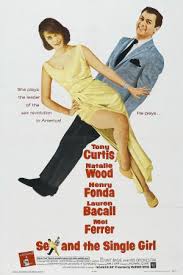
SEX AND THE SINGLE GIRL
US, 1964, 114 minutes, Colour.
Tony Curtis, Natalie Wood, Henry Fonda, Lauren Bacall, Leslie Parrish, Edward Everett Horton, Mel Ferrer, Fran Jeffries, Stubby Kaye.
Directed by Richard Quine.
A pleasant if a inconsequential sex farce comedy, sixties' style. Its strength is in its stars, although they have done this kind of material quite often. Lauren Bacall and Henry Fonda are particularly strong stars for supporting roles. There is a very humorous opening with Edward Everett Horton.
However, the film eventually turns into a farce of mistaken identity and rather elaborate car chases. It is interesting to note that one of the co-writers of the screenplay is Catch 22 author Joseph Heller. Music is bright and by Neal Hefti, who wrote The Odd Couple and Barefoot In The Park. Director Richard Quine has made a lot of pleasant entertainments including a number of films with Jack Lommon and Kim Novak. Bell Book & Candle, The Notorious Landlady.
1. The perennial appeal of sex and marital farce comedy? The tradition of the thirties' screwball comedy, sentiment and traditional values, permissive touches?
2. The growing frankness and openness of the sixties? The title? Magazines and books? Helen Gurley Brown's books and articles? Trends? Impact then, now? The satirical touch of the screen play especially with the chief's satiric opening with the work of the magazine?
3. The glossy style of the film? Neal Hefti's music, song? The strength of the cast?
4. The conventions of the genre? Hero and heroine, older married couple, work in the office, other girls? Types? Marital mixups, deceptions? Farcical situations? The lack of originality of the plot - but audience expectations of this kind of entertainment?
5. The background of open discussion about sex in the sixties, the potential for scandal and magazines capitalising on this? Traditional American values? The place of sex surveys in America? Psychology? Hypocrisy and double values? Big business?
6. Natalie Wood and Tony Curtis in this style of comedy? Helen and her prim style, sure of herself? her writing, her refusal to interview Bob, her clients, Bob coming under a false name? Her theoretical approach to things? Rudy and his advances? The gradual falling in love with Bob? The contact with Sylvia and the mixup with the three Sylvias? A put-upon heroine?
7. Tony Curtis in wolf style as Bob? His work for Stock Magazine, his infiltrating himself, confidence in himself, wanting a scoop? His cynicism as regards Helen? His using Frank's name, the humour of the sessions? His gradual change? His organising Gretchen and Susan to be Sylvia? His comeuppance and change of heart?
8. Frank and Sylvia - the traditional older couple, values? The friendship with Bob? Their being used? The build-up to the clash? Sylvia fighting Frank? Lauren Bacall and the acidity of her style?
9. Rudy and his place as a doctor, his devotion to Helon? Gretchen and her ambitions to be a singer, the audition, her willingness to pose an Sylvia, her devotion to Bob? Susan and her work an secretary? The mixups?
10. The length of film given to the chases? How well executed were they? The policey the cabbies? Frantic American farce?
11. The perennial issues of male-female relationships, the battle of the sexes? The traditional values explored and promoted?
Published in Movie Reviews
Published in
Movie Reviews
Tagged under